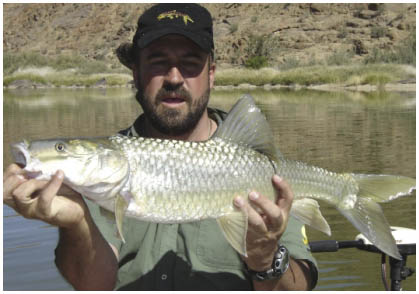



Fly fishing for Largemouth Yellowfish
The Largemouth Yellowfish or Barbus Kimberleyensis is the largest scale bearing fish in Southern Africa and indeed in South Africa. It has a larger mouth than other yellowfish that terminates in thin lips. It has two pairs of smallish thin barbells with dorso –lateral eye placement. One of the differences between it and the smallmouth yellowfish is that you cannot see the eyes from below and more visible from the top. In other words they are good hunters of prey upwards. Their colours vary from silver to yellow but the younger fish of 300 mm are very silver in colour. It is said that the SA record is 22,2 kilograms. The females grow larger than the males and gets older. A very sensitive and scarce species but probably the most valuable sports angling species in Africa with the Perch, Tiger and Goliath tiger – to date. Of course the mudfish, catfish are two species together with the Clanwilliam yellowfish and other yellowfish and a few other fish species that have not reached their full potential in the preferred list of fishermen though...maybe a good thing!. It is my opinion that anglers up until now have not been able to land the larger Largemouth yellowfish specimens, even on conventional tackle. We specialise in monster catfish and the most brutal takes ever while catching catfish with 50 pound line and 80 pound leaders have been largemouth yellowfish. There is just no way a fly rod of 12 weight will land a 30 kilogramer in our rivers. Well let me say the chances are slim. Everything in our powers should be done to eradicate the conventional anglers that are successful with this species and kill every fish they catch. I know of anglers along the Vaal River that have only been fishing for this species and will catch as much as 15 Largemouths and above 5-10 kilograms on every outing and eat and sell them. At least small efforts are made to research these fish over the last few years but almost nothing have been done as far as I’m concerned. The 1st telemetry program on the Vaal have revealed nothing as far as I m concerned to really assist with the conservation of this specie. The main reason why we should do everything in our powers to prevent the poaching and killing and even catching these species is that they take 5 years to grow only 300 mm and matures at 6 and 8 years respectively when the anal fin turns slight orange. Females the longest.





How to fish for them
As they are predators they eat mice, rats, reptiles such as lizards, large insects that fall into the water, such as bugs, grasshoppers, scorpions, crabs, small fish, frogs, small birds etc. They are also quite omnivorous as all the conventional anglers records show. They take mielie pips, fish heads, fish fillets etc.
So in essence the angler needs to mimic the prey at the right habitat like with all other fish that are targeted. Slowly drifting and casting to right underneath trees where birds normally sit on overhanging branches, Casting a fly to above a boulder and allow it to drift into the eddy behind the rock. Along rocks sticking out of the water, in the back water of pools and even below rapids. No noise should be made and you basically have one cats per spot. Crab patterns work right onto the bank. The most underutilised areas .The crab can literally be dropped onto the bank and slowly pulled into the water .
What tackle to use
Anything smaller than a 7 weight is pushing it although 5/6 weights are used mostly as anglers targeting Smallmouth’s hook into them by accident. Of course it is easier to catch with a 5/6 all day than a 9 weight but a 9 is my preferred weight together with a 10 weight. They are predators that take insects when small but heavy piscivorous above 300 mm it is said. Floating to intermediate and at times sinking line for strong flowing waters . I don’t go lighter than 6 kilos with my tippet.
Fly patterns
Mice patterns crab patterns, streamers, deceivers, zonkers, pups, peddars dragon, Dahlbergs divers, Basic bugs, frogs and large nymphs
The fight
Well its statistics show that it almost always go 12 rounds.....and still win on a knock out. Lots of times they win the fight on a rod break off during the strike. Other times by pulling the rod out of the anglers hands during the take. Sometimes they snap the leaders or the fly and sometimes they just spit out the fly. Lots of times though they tend to “miss” the fly with the first take with a very large splash. It is not a known fact what happens during these misses. It could be that it is just so developed that it can in a fraction of a second feel that the content of the fly is not the real McCoy or the prey item.
Records
No IGFA line class records. The largest on fly on picture is around 10 kilograms. I shall be silent on our largest sizes and the location for the mean time

Catfish Joe Productions 2000 - 2011 Copyright Protected, All rights reserved
